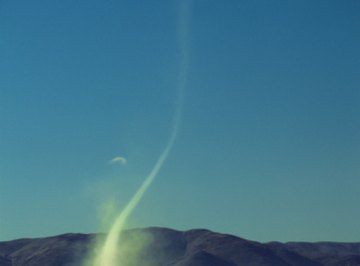
Sandstorms form over areas with dry climates, such as the Sahara region in Africa, the Gobi in Asia and in the Southwest portions of the United States. The sand whipped up by the wind can create dust devils and can even be carried across the oceans to other continents. Middle school students' science projects can range from making their own sandstorms to covering sandstorms on other planets.
Make a Table Top Sandstorm
Create sandstorms for the science project. Place a small amount of flour in a clear plastic box with a hole at one end. Blow into the hole gently to get the flour to fly off the surface of the box. The flour may stay in the air for a long period of time. The more flour you blow into the air, the longer it will take for all the particles to settle. The same happens in dust storms. Another experiment is to take a glass of water and place a few drops of milk into the water. The milk will separate as it makes its way to the bottom of the glass. The milk will represent sand moving through the atmosphere.
Tracking Sandstorms
The deserts of the world are always producing sandstorms. You can track these storms and storm predictions using the Nasa Total Ozone Mapping Spectrometer, which tracks dust and smoke patterns worldwide, and the Naval Research Laboratory Monterey Aerosol webpage which predicts weather patterns, including dust. For the project the student can help predict the sandstorm patterns and how the dust from the storm will travel. Select a region, such as the Sahara, and track the dust as it reaches the Caribbean or even into the United States.
Catching Sandstorm
Depending on the region, a student may be able to capture dust from another continent. Use the NASA and Naval websites to track dust and aerosols in your area. Place air filters and slides outside to capture dust and other particles from the air. You should place the slides in areas off the ground, such as on an outdoor table, to avoid their being stepped on and broken. Review the particles under a microscope and compare them to dust particles. Sand particles will have sharper, more defined edges under the microscope.
Mars Sandstorms
In 2001 Mars had a global sandstorm that covered the entire surface of the planet. Make a science project detailing what happened to the planet as the storm proceeded, using pictures from NASA websites showing Mars at the beginning of the storm and as the storm progressed. When the sandstorm occurred, the upper atmosphere of the planet was filled with dust and the temperature of the upper atmosphere raised by 80 degrees. However, the surface temperature of the planet cooled because of the storm. Discuss in your project what the reasons for this may have been and whether the same thing happen here on earth.
References
Resources
About the Author
Michael Carpenter has been writing blogs since 2007. He is a mortgage specialist with over 12 years of experience as well as an expert in financing, credit, budgeting and real estate. Michael holds licenses in both real estate and life and health insurance.
Photo Credits
Dynamic Graphics Group/Dynamic Graphics Group/Getty Images
